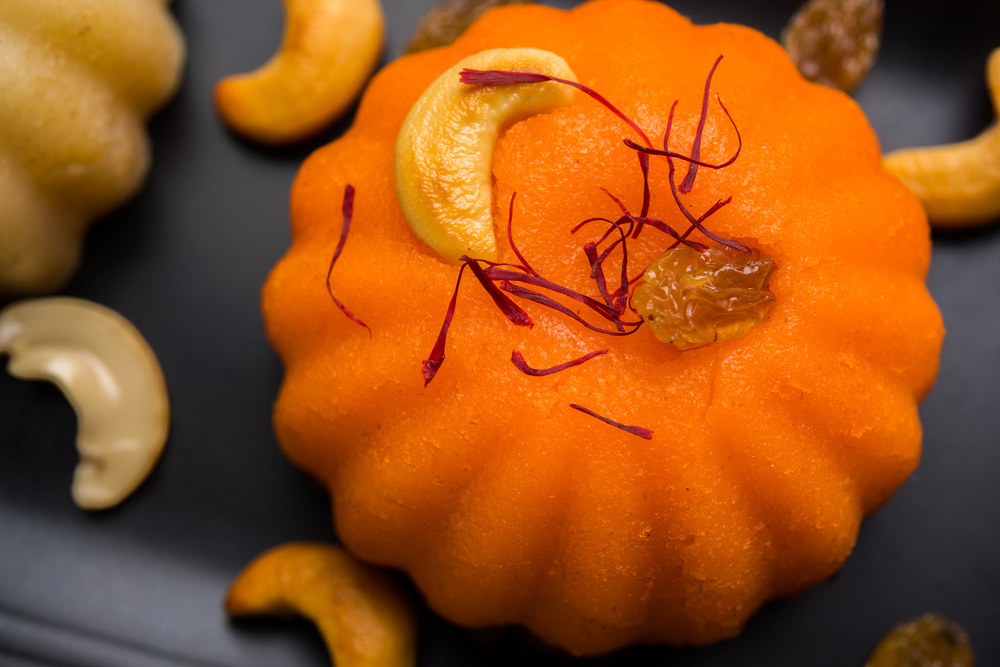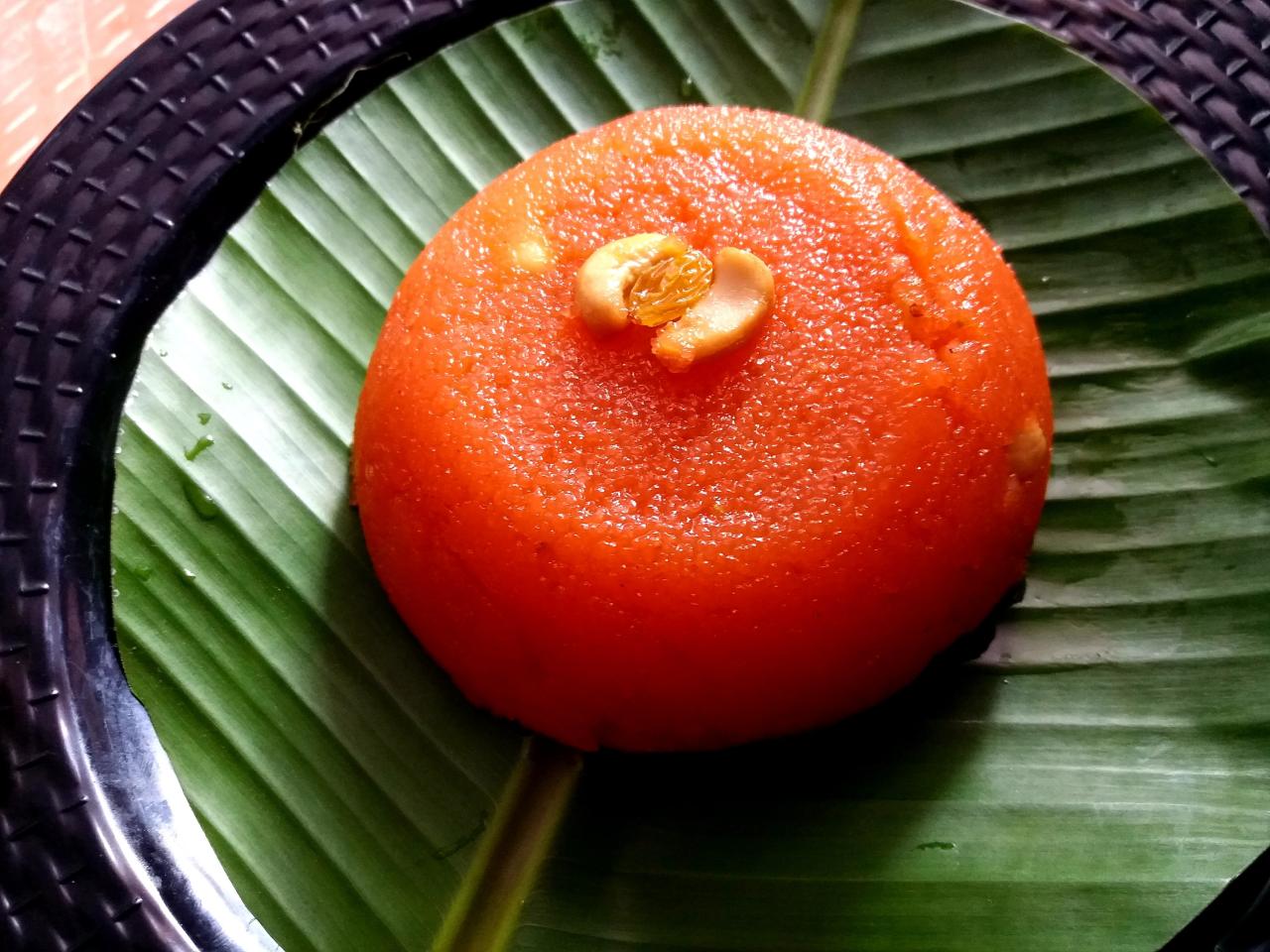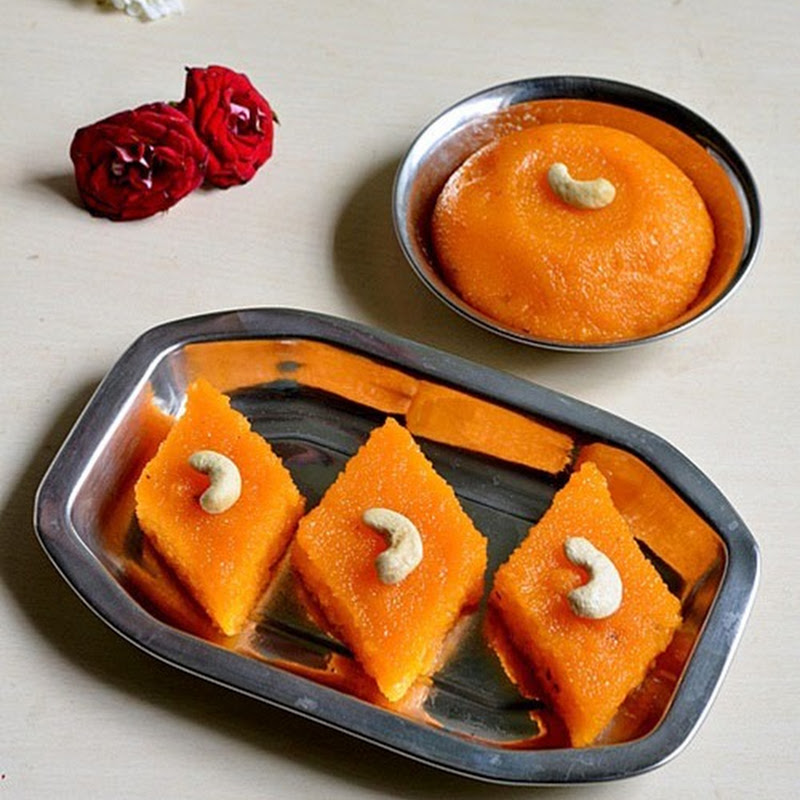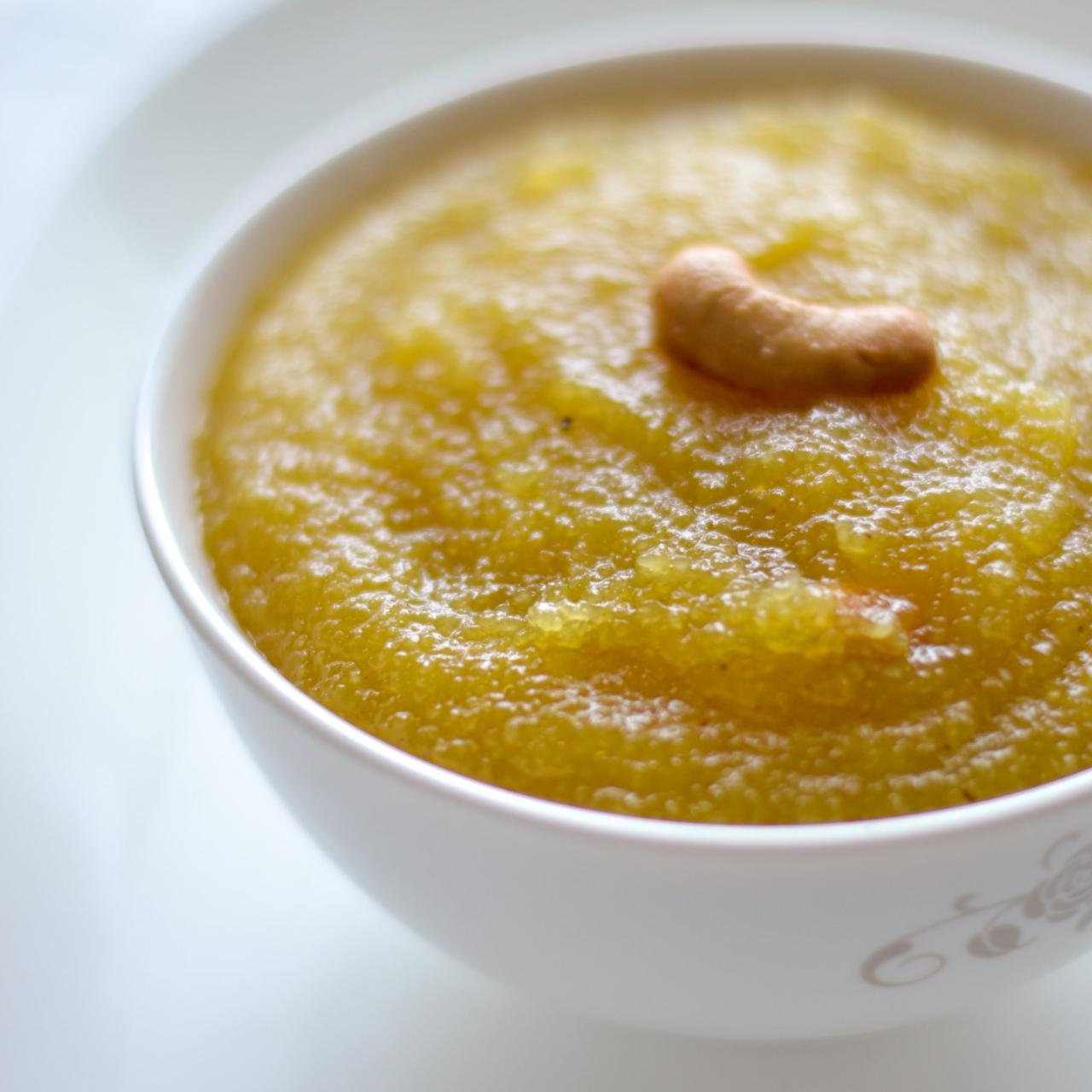Rava Kesari is a vibrant and popular Indian dessert known for its bright orange color, luscious texture, and delightful flavor. It’s a semolina-based sweet dish that holds a special place in Indian cuisine, often made during festivals, special occasions, and celebrations across various parts of India. The name “Kesari” refers to the saffron color of the dish, which is traditionally achieved using food coloring or saffron strands, giving it an attractive look and a subtle fragrance.
The core ingredient of Rava Kesari is rava, also known as semolina or sooji in different regions. The dish is prepared by roasting rava until it reaches a golden hue, then cooked with a generous amount of ghee (clarified butter), sugar, water, and milk to achieve a soft, pudding-like consistency. The rich taste of Rava Kesari is further enhanced with the addition of cardamom powder, nuts such as cashews and almonds, and raisins, providing a crunch and bursts of sweetness throughout.
Making Rava Kesari does not require complex techniques, making it a favorite among those new to Indian cooking as well as seasoned chefs. Its simplicity, combined with the ease of customization according to personal preference, makes it not just a dessert but a canvas for culinary creativity.
Rava Kesari Recipe


Rava Kesari
Equipment
- 1 medium saucepan
Ingredients
- 2 cups water
- 4 teaspoons ghee divided
- 2 cups sugar
- 1/8 teaspoon pineapple extract
- 1/8 teaspoon edible orange food coloring
- 1 cup roasted semolina
- 10 cashews
- 10 raisins
Instructions
- In a medium saucepan over medium heat, combine the water and 1 teaspoon of ghee. Cook for 4 to 5 minutes, until small bubbles start to form. Add the sugar and cook for about 2
- minutes, until the sugar dissolves. Add the pineapple extract and food coloring and bring the mixture to a rolling boil. Boil the sugar syrup for 3 minutes.
- Stirring constantly, slowly add the roasted semolina to the sugar syrup.
- Stir in 2 teaspoons of ghee and cook for 4 to 5 minutes, stirring constantly, until all the moisture is absorbed. Turn off the heat.
- In a small skillet over medium heat, melt the remaining 1 teaspoon of ghee.
- Add the cashews and raisins and cook for about 1 minute, until the cashews are golden brown. Stir them into the kesari. Serve warm.
Notes
Cooking Tips about Rava Kesari

- Roast Rava Properly: The key to a great Rava Kesari is the roasting of the rava (semolina). It should be roasted in ghee on a low to medium flame until it turns golden brown, emitting a nutty aroma. Be careful not to burn it.
- Use the Right Water Ratio: For a soft and fluffy texture, ensure you use the correct ratio of water to rava. Typically, a ratio of 1:2.5 or 1:3 works well (1 cup of rava to 2.5 or 3 cups of water). Adjustments can be made depending on the desired consistency.
- Add Sugar Carefully: Add sugar only after the rava is well-cooked in water. Adding sugar earlier can interfere with the absorption of water, preventing the rava from cooking properly and resulting in a hard texture.
- Consistent Stirring: After adding sugar, the mixture tends to thicken quickly and may form lumps. Continuous stirring is crucial at this stage to ensure a smooth consistency.
- Infuse Flavors: Cardamom powder is essential for that authentic flavor. Consider adding it towards the end of cooking. Also, saffron soaked in a little warm milk can be added for both color and aroma. If using food coloring for the traditional Kesari hue, add it sparingly.
- Garnish Generously: Fried cashews and raisins in ghee not only add to the taste but also provide a delightful contrast in texture. Add them as a garnish before serving.
- Control the Amount of Ghee: While ghee is important for the richness and moistness of the Kesari, its quantity can be adjusted according to personal preference. A generous amount results in a richer dessert, while a lesser amount makes it lighter.
- Serving Warm: Rava Kesari tastes best when served warm. If it has cooled down and thickened, a quick reheat with a tiny splash of water or milk can bring back its soft, pudding-like consistency.
- Creative Variations: Feel free to experiment with additions like pineapple chunks or apple pieces for a fruity twist. These should be added after the rava is cooked but before the sugar, to ensure they blend well with the kesari without becoming mushy.
Serving suggestions about Rava Kesari

- Temperature Variation: Serve Rava Kesari warm or at room temperature to fully appreciate its flavors and aroma. When served warm, it has a softer consistency that many find comforting.
- Garnishing for Visual Appeal: Top the dish with additional fried nuts (cashews and almonds) and raisins just before serving. A sprinkle of cardamom powder or a few strands of saffron can also add a touch of elegance and fragrance.
- Portion Presentation: For individual servings, consider molding the Kesari into shapes using small bowls or cups. Invert the Kesari onto plates to give them a dome shape, adding a professional touch to the presentation.
- Combining Textures: Pair Rava Kesari with a scoop of vanilla ice cream for a delightful mix of warm and cold elements. The contrast in temperatures and textures between the creamy, cold ice cream and the warm, soft Kesari makes for an indulgent treat.
- Festive Serve Ware: Serving Rava Kesari during festivals or special occasions? Use traditional or festive serve ware, such as silver dishes or colorful ceramic bowls, to enhance the celebratory feel.
- Drizzling with Toppings: A light drizzle of ghee over the warm Kesari just before serving can intensify its rich flavor. Alternatively, a sprinkle of powdered sugar or decorative edible flowers could add an extra layer of sweetness and appeal.
- Pairing with Spicy Snacks: Balance the sweetness of Rava Kesari by pairing it with a savory or spicy Indian snack like mixture or masala peanuts. This combination offers a delightful balance of flavors – perfect for teatime.
Top 5 FAQs about Rava Kesari

- What is Rava Kesari? Rava Kesari is a vibrant and popular Indian sweet dish known for its bright orange color and delicious taste. It’s made from semolina (rava), ghee, sugar, water, and milk, often flavored with cardamom, saffron or food coloring for color, and garnished with nuts and raisins. It’s a staple in Indian cuisine, frequently prepared during festivals, special occasions, and celebrations.
- Why is Rava Kesari so popular in Indian cuisine? Rava Kesari holds a special place in Indian cuisine due to its simplicity, ease of preparation, and delightful taste. The combination of semolina roasted in ghee, combined with the sweetness of sugar and the richness of nuts, makes it a favorite. Its appealing color and texture, along with the ability to easily customize it according to personal preferences, also contribute to its popularity. It embodies the warmth and hospitality inherent in Indian culture.
- Can Rava Kesari be made vegan? Yes, Rava Kesari can easily be adapted to a vegan diet. By substituting ghee with plant-based oils or vegan butter and using water or plant-based milk instead of conventional milk, one can prepare a vegan-friendly version of this dessert without compromising on its traditional flavor and aroma.
- How do you achieve the perfect texture for Rava Kesari? Achieving the perfect texture for Rava Kesari involves roasting the semolina until golden brown without burning it, using the correct water-to-rava ratio for softness, stirring continuously to avoid lumps, and cooking it until it reaches a pudding-like consistency. The dish should be moist but not overly dense, with a slight fluffiness to it. Consistent stirring and careful addition of liquids at various stages are key.
- Can Rava Kesari be stored and served later? Yes, Rava Kesari can be stored in the refrigerator for a few days and still retain its delightful taste. It’s best served warm, so when ready to serve, simply reheat gently on the stove or in the microwave, possibly adding a small amount of water or milk to bring back its soft consistency. This makes Rava Kesari a convenient dessert option for preparing ahead of time or enjoying leftovers.
Rava Kesari is more than just a dessert; it is a vibrant embodiment of Indian culinary tradition, celebrated across varied regions of India for its delightful flavor, eye-catching color, and rich texture. Its simplicity and the joy it brings to people of all ages have cemented its status as a beloved treat, often marking festive occasions, religious ceremonies, and family gatherings. The process of making Rava Kesari—with its aromatic roasting of semolina, the gentle simmering in ghee, water, and milk, followed by the addition of sugar, cardamom, and a lavish sprinkle of nuts and raisins—highlights the traditional cooking techniques that are integral to Indian gastronomy.

Leave a Reply